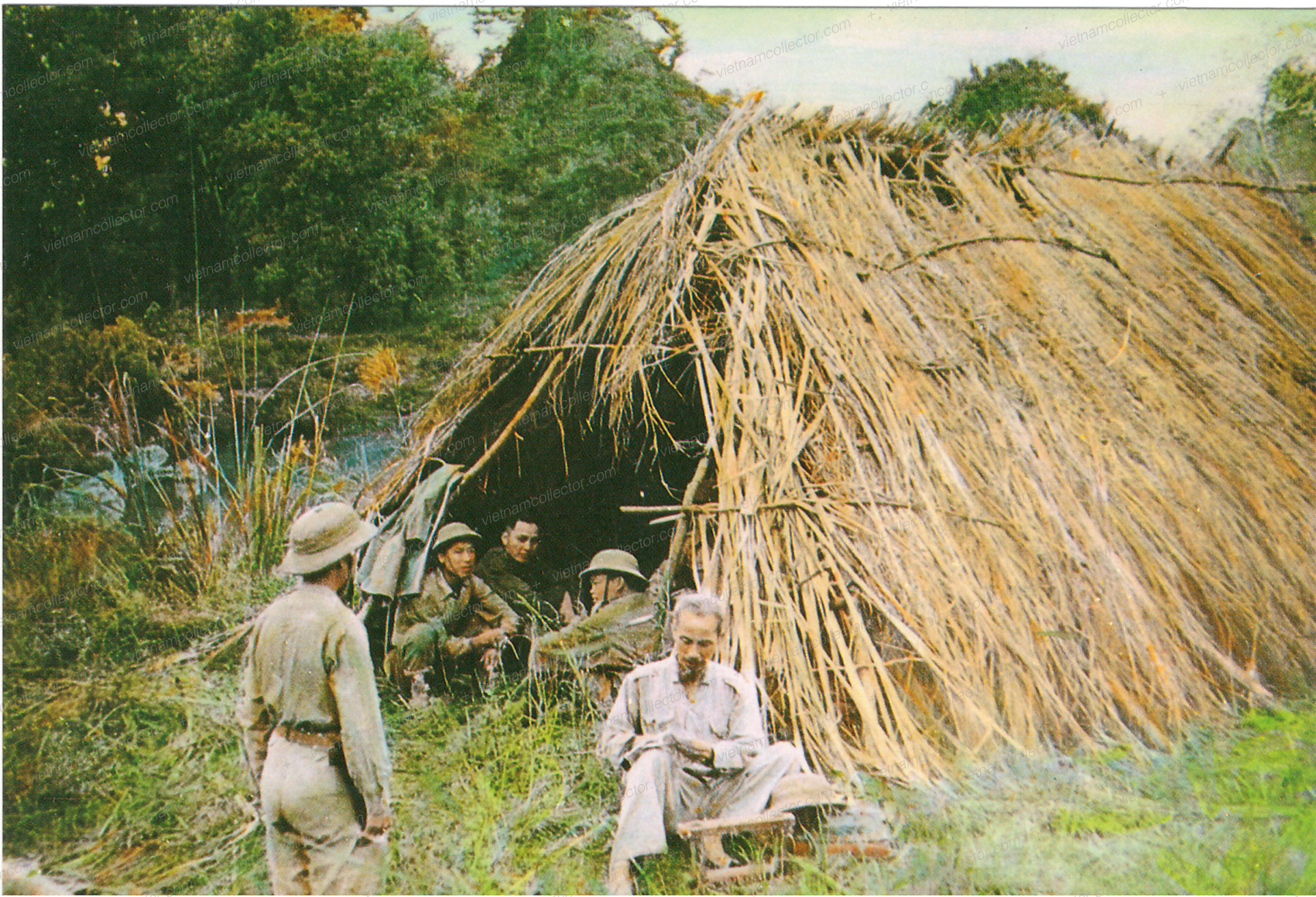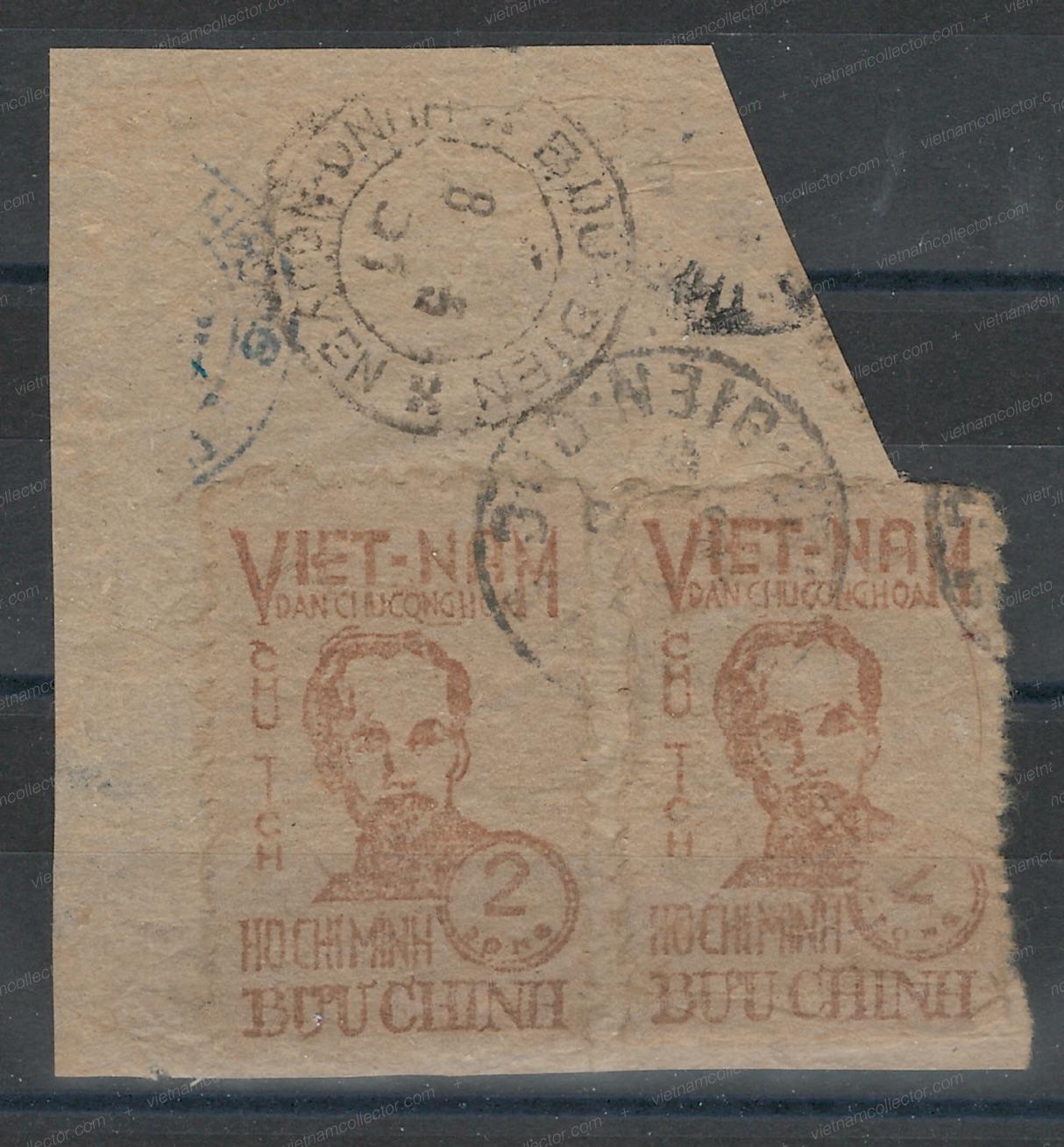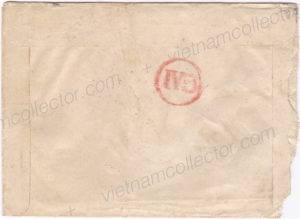After the “Clash of Hanoi” in December 1946, the Viet Minh were driven out of all major towns as the French took control of them and all important means of industry and transportation throughout the country. The Viet Minh found refuge in the Northern mountain areas of Tonkin on the border to China. This, of course, meant, that the organization had lost its access to professional printing equipment and hence the ability to produce sophisticated postage stamps. As result, the first printing of Ho Chi Minh stamps after going into hiding was a rather primitive affair. They were made of hand-carved cliches on fibrous waste paper, printed with hand made ink in the standard letter press method invented by Guttenberg and perforated by tiny nails that were inserted between two bamboo slats. The bamboo slats were pressed down by two people on ten sheets at a time.[1] The catalogue makers do not seem to agree on when these stamps were exactly issued. Scott states simply 1948 while Michel writes that the stamps were issued in 1948/1949. The most exact date of issuance comes from the Vietnamese Postage Stamp Catalogue 1945-2005 which documents that the 2d value was issued in May of 1949 and the 5d value in December of 1950. Jean Goanvic reports on his website (http://www.histoire-et-philatelie.fr) that the standard letter rate went from 50 xu in the end of 1947 to 2 Dong in the second half of 1948 and to 5 Dong between the spring and end of 1950. This is based on the few existing Viet Minh covers from that time. If he is correct, then none of the catalogues appear to have the correct date(s). Based simply on the usage data it would make sense for the 2 Dong value to have been issued towards the end of 1948 and the 5 Dong value sometime in 1950.
Postcard showing Ho Chi Minh among soldiers during the frontier campaign in 1950

Michel distinguishes between two printings on both stamps. The first print of the 2 Dong value is printed in brown, while the later, second, printing was done in light-brown. One has to put both versions next to each other to appreciate the difference. Also, the colors as stated in the catalogue do not correspond to the Michel color guide. Applying the stamps to the color guide, the stamps are actually blackish-brown ochre (described as brown in the catalogue) and ochre (described as light-brow in the catalogue). The 5 Dong value comes in red (first printing) and orange-red (second printing).
[1] Information provided by Mr Le Quang Huy (high Viet Ming postal official) to the philatelic author Ta Phi Long
Here ara pairs of 2 Dong light-brown and the 5 Dong red
Here are two single stamps of the lighter orange-red variety.
Below is a complete mint sheet of the 2 Dong value in light-brown. Notice the slight differences on each stamp caused by hand-carved cliches.
Errors do occur. Below is a strip of four 2 Dong values in brown where the vertical perforation between the two stamps on the right is missing.
Strip of four mint 2D stamps that are imperforate vertically

Pair of the 2D stamp which is imperforate on the right.

Here is strip of ten 5 Dong values where the horizontal perforation on the left row is barely visible and missing entirely on the right row. These errors were a result of the rather primitive manual perforation effort described above.
Pair of the 5D stamp which is imperforate on the left

Postally used stamps or covers are extremely rare. Below is the collection yield from over 25 years of effort on postally used stamps which often meant buying a lot of complete old collections in order to get to them. Most postally used stamps come from collections in the former East Germany and Eastern Europe as collectors from these countries did have contact to people in North Vietnam starting in the middle 1950s. Remember, that the Viet Minh, not being recognized by the Universal Postal Union (UPU) could not use their own postal system to send mail abroad. They either had to rely on private couriers to bring mail across the order to China or Russia (which recognized the Viet Minh movement in January of 1950) for onwards transportation or use the enemy’s postal system (i.e. the French Post Offices in Indochina) which was of course not the preferred route for confidential messages. This probably explains why most of the surviving stamps were cancelled in the mid- to late 1950s. After the Geneva convention in 1954 the Viet Minh became recognized by Western Governments and hence a member of the UPU. So from that date direct postal communication between North Vietnam and Western countries was possible. Of the seven stamps below five are from the first printing and two from the second printing. Take a closer look at the two stamps on the right. They were both cancelled in Ha Giang a town in the mountains north-west of Hanoi. Here the postal official obviously could no be bothered to tear the stamps from the sheet since the perforation was so poor. He/she instead simply used scissors to cut them out. 
Below are two pieces from a package or letter. The left piece is a rare mixed franking of the 1st and the 2nd Ho Chi Minh issue that was cancelled on June 17th, 1951. Please note that the 2 Dong value was again cut by scissors. The piece on the right was cancelled by a provincial red circular cancel. The date was, as was common, inserted by hand and it looks like the use date was September 15th, 1951.
Rare multiple franking of the 2D value paying the up-rated 40 Dong (4D x 10) standard letter tariff that was in force from March, 1951 through August of 1951. Transit cancel from Hung Nguyen located to the West of Vinh in the coastal province dated May 8th, 1951. Illegible Bien Cuc Viet Minh departing cancel.

Cancelled specimens of the 5 Dong value are no more numerous. Four cancelled specimens is all the editor has to show for his long time collection efforts. All of them are from the first printing in red.
Michel values mint stamps of 2 Dong in light-brown and 5 Dong in orange-red at €10, which is about right. Complete sheets of the second printing that probably came from postal archives could be purchased from Cotevina until the mid 1990s and so these mint stamps are not particularly rare. This is not true for mint stamps of the first printing (brown and red). If we apply simple logic, then it is highly likely that the first printing had been sold/used up by the time the second printing was undertaken. Raw material (paper, ink, etc.) was so difficult to obtain that no one would think of doing a second print run just for fun. This means that there should be very fewer surviving mint specimens of both stamps and this is exactly what we are seeing. Mint stamps of the first printing are much scarcer than indicated by the catalogue value. Clearly €20 per stamp, as suggested by Michel, would not be adequate compensation for such rare stamps.
A similar assessment can be made for the used prices in Michel. €200 for used stamps of the first printing is about right, though the 5 Dong value in red appears to be rarer than the 2 Dong value in brown and so should be valued a bit higher. Due to very high inflation the 5 Dong standard letter tariff was only in force for a few months and so it is logical that fewer cancelled stamps should survive. However, pricing used stamps of the second printing with only €20 does not make any sense when one considers that they are hardly ever offered in the market place. As a matter of fact, as demonstrated with the seven specimens above, timely cancelled 2 Dong values in light-brown appear to be rarer than the cancelled brown version. Also the total lack of any timely cancelled 5 Dong values in red-orange indicates that the second printing is actually more rare cancelled than the first printing. Again, this all makes sense, if one presumes that most of the stamps from the first printing were all used up prior to the second printing being made.
Beware of forged cancellations and cancellations that were applied long after the stamps were issued. Below are two sheets that were sold by Cotevina in the 1990s. The sheets are of the second printing (light-brown and orange-red) and they were all cancelled in February of 1990 or more than 40 years after the stamps were issued. Since all North Vietnamese stamps from 1945 until today are still valid for postage one cannot call these cancelations forgeries. However, since the country’s currency has been devalued three times (by a factor 10 in 1953, a factor of 1,000 in 1959 and a factor pf 10:1 in 1985) the nominal of these stamps today would only amount to 0.00002 or 0.00005 current Dong which made them basically worthless in 1990 when the standard letter rate amounted to 100 Dong. Clearly these favor cancelled stamps are not worth nearly as much as stamps that were cancelled in the late 40s or the 1950s.
Here is a the favor cancelled set with the modern small Hanoi cancel from the mid 1990’s.

Below is a very rare letter sent from Binh Tu via the administrative center in Quang Tri Province. It carries the LK IV red censor stamp of Lien Khu IV (4th Interzone) along with the red and blue crosses that were applied by French censors. Unfortunately no date was entered by the postal official in Quang Tri but given the single 2 Dong franking the letter is most likely dated from the end of 1950 to the beginning of 1951. The standard letter rate at the time was 20 Dong. Given rampant inflation the Viet Minh had given up on printing new stamps and simply sold the old stamps at ten times the nominal value. Therefore the 2 Dong nominal value represents a 20 Dong franking.
Here is another very rare letter from Quang Tri Province franked with a multiple franking of the 2 Dong value in brown. Again no cancel date can be made out. The letter is most likely from the end of March 1951 to November 1951 when the standard letter rate was 40 Dong. So the 4 Dong stamps were up-valued ten times to represent a 40 Dong franking.
Very rare local letter with a multiple franking of the 2D value in brown in which the 4D stamps were up-valued ten times to represent 40 Dong. . The letter was cancelled on October 23, 1951 in the city of Xã Châu Phong – Hà Tĩnh and addressed to Mr. Hà Văn Điếm at B.D.H.V. which stands for Bình Dân học vụ in the city of Thừa Thiên. B.D.H.V. was an organization for the education of the people.

Very rare local letter sent from a rehabilitation institute („dưỡng bệnh Nghệ An Province“ may have been an early re-education camp) addressed to Nguyễn đăng Lãng, Teacher at the Primary School in Phong Phú – Phong Điền, Thừa Thiên. The oval cachet is from the Committee of Traffic in Ánh Sao in Nghệ A Province which dates the letter to October 17th, 1951. The postal cancel (Buu-Dien) dates a day later, October 18th, 1951, but the bottom part that indicates the city is hard to read but it is likely Đô Lương which is located in Nghệ An Province. The boxed message “thu can'” means “necessary letter” which may just be indicative that the letter was official and not personal mail. The letter is franked with two 5 Dong in red for a total of 10 Dong which were sold ten times up-rated for a postal value of 100 Dong at the time. Note that the stamp pair is imperforate, it was simply torn from the sheet. This represents the second weight level of the 50 Dong letter tariff that that came in force in the fall of 1951. Red circular LK IV censor stamp Nr. 2.


The Viet Minh started to issue their own aluminum coins on December 1st of 1945. The first banknotes were issued in 1946 (“Dong Duong”) however, they were already exchanged on May 15th, 1947 according to Government degree 48/SL 1:1 into “Viet-Nam Dong“. Below is a sample of Viet-Nam 50 Dong banknote issued by the Viet Minh in 1947/1948, a time when they were basically being tolerated by the French colonial force and hence had better printing facilities available. On May 6, 1951, Ordinance 15/SL signed by President Ho Chi Minh was issued to approve the establishment of the National Bank of Vietnam. On May 12, the bank officially released banknotes named “National Bank of Vietnam” to replace the money issued of the Ministry of Finance in 1947. The exchange rate was 10 dong of the old banknotes for 1 dong of the new one. This money exchange took place for up to 20 months, the longest in the history of Vietnam’s money exchange.
The third time of money exchange took place in February 1959, with the exchange rate of 1 dong of the new money for 1000 dong of the old one. With this new value, from February 1959 to October 1960, 1 dong was equivalent to 1.36 Russian ruble or US$1.2.
The 1959 money exchange is considered the most “spectacular” in the history of Vietnam’s currency. In October 1961 the currency of the National Bank of Vietnam in the northern region was renamed into the money of the State Bank of Vietnam with the same face values, to not have the same name with the money of the National Bank of Vietnam in the southern region.
(Reference: https://english.vietnamnet.vn/fms/special-reports/83771/over-600-year-history-of-vietnam-banknotes.html).
Front

Reverse

Front

Reverse

Sample of the 100D bank note issued by the Viet Minh in 1948.
Front

Reverse

Registration Nr. 100022



















Comments are closed.